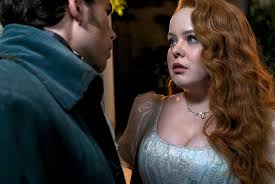OK, I’ll admit that I once had misgivings about “Bridgerton.”
When the show arrived – on Christmas Day, 2020 – I said the show is “part classy Jane Austen and part tawdry Harlequin novel.”
It still is, but the classy side keeps gaining. This third season – which released its second half on Netflix Thursday (June 13), four-weeks after its first half – is a delight, partly because of the surprising choice (shown here) of whom to focus on.
(One caution: I won’t spoil anything that happens in this second half. I will, however, talk about things that preceded it. If you haven’t seen the first half — or the first two seasons — stop reading and start watching.)
“Bridgerton” is from Shonda Rhimes, the superproducer of “Grey’s Anatomy,” “Scandal” and more. It’s based on novel that offered a revisionist history of Queen Charlotte’s reign of England.
Then Rhimes revised even further, including her trademarks, full-scale diversity. The Blacks in this story include the Queen, her best friend, several noble families and the leading man in the first season.
Still, the focus is on two white families, each headed by a widow. The Bridgertons have prosperity and eight children; the Featheringtons have three girls – two rather dim-witted and one quick, clever and unnoticed.
That’s Penelope, who fits none of the measures of high society. She’s short (5-foot-1), chubby and often ignored. Her best friend (the brainy Eloise Bridgerton) has better odds; Eloise’s handsome brother Colin has great odds.
In the first season, “Bridgerton” stuck mostly with the expected. Daphne Bridgerton was whisked away by a handsome nobleman.
The story and dialog were fairly stiff, salvaged by a skilled cast, lush production values and a closing surprise: Penelope – the overlooked, underappreciated teen – writes the anonymous “Lady Whistledown” gossip sheet. Ignored on the sidelines, she had wise, witty views of her world.
A bigger surprise came early in this third season: Her childhood friend Colin coached her in the ways of romance – then fell wildly in love with her.
Yes, we’d seen the coach-turned-lover twist before. But this time it was beautifully done. Nicola Coughlan and Luke Newton gave the characters deep pools of humanity, boosted by sharp writing and directing.
That still left huge obstacles for the second half. Eloise – Colin’s sister, Penelope’s former friend – knows Penelope’s secret and is bitter about a Whistledown comment. She could tell her brother, who has his own grudge against Whistledown.
Then there are others to worry about – Francesca Bridgerton, the quiet musician, needs attention. So does her widowed mom.
Some of the plot twists – especially one introducing the upper-crust world to sexual threesomes – sputter, The weddings are surprisingly modest ;the final hour is given to too many long speeches.
But those are overlooked, when the show returning to the wide-eyed world of Penelope. The Austen side triumphs, the Harlequin one retreats and “Bridgerton” is a delight.

With the right heroine, “Bridgerton” soars
OK, I’ll admit that I once had misgivings about “Bridgerton.”
When the show arrived – on Christmas Day, 2020 – I said the show is “part classy Jane Austen and part tawdry Harlequin novel.”
It still is, but the classy side keeps gaining. This third season – which released its second half on Netflix Thursday (June 13), four-weeks after its first half – is a delight, partly because of the surprising choice (shown here) of whom to focus on.
(One caution: I won’t spoil anything that happens in this second half. I will, however, talk about things that preceded it. If you haven’t seen the first half — or the first two seasons — stop reading and start watching.) Read more…